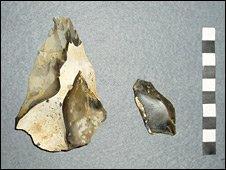Artefacts hint at earliest Neanderthals in Britain
- Published

The flints date to a time when no humans were thought to be in Britain
Archaeologists have found what they say is the earliest evidence of Neanderthals living in Britain.
Two pieces of flint unearthed at motorway works in Dartford, Kent, have now been dated to 110,000 years ago.
The finds push back the presence of Neanderthals in Britain by 40,000 years or more, said Dr Francis Wenban-Smith, from Southampton University.
A majority of researchers believe Britain was uninhabited by humans at the time the flint tools were made.
An absence of archaeological evidence suggests people abandoned this land between 200,000 years ago (or 160,000 years ago, depending on who you ask) and 65,000 years ago.
But one researcher, unconnected with the study, said he was not convinced by the evidence presented so far.
Dr Mark White, from Durham University, said he would like to assess the findings in detail before considering whether they posed a challenge to the majority view that humans were absent from Britain at this time.
A flint hand tool and a waste flake discarded by a Neanderthal whilst making a similar tool were unearthed at the M25 / A2 road junction at Dartford, during an excavation funded by the UK's Highways Agency.
Dr Wenban-Smith and colleagues from Oxford Archaeology have dated the sediments in which the hand axes were sitting to 110,000 years ago, placing them squarely within the "abandonment period".
The finds at Dartford come from when sea levels were dropping after a period when they were high enough to make the English Channel impassable.
Neanderthals may have been drawn to Britain by mammoth and rhino herds
"We know that Neanderthals inhabited Northern France at this time, but this new evidence suggests that as soon as sea levels dropped, and a 'land bridge' appeared across the English Channel, they made the journey by foot to Kent," said Dr Wenban-Smith.
The dearth of evidence for human occupation in Britain between 200,000 and 65,000 years ago has perplexed researchers. The English Channel would have posed a physical barrier to humans trying to cross from the continent.
But sea levels fluctuated during this period; there were other times when hunters could have walked from France to southern England.
For instance, from 200,000-130,000 years ago the sea level was predominantly low. Humans should have been able to get here, but, for some reason, they did not show up.
Opportunity knocks
"It could be something subtle like the rapidity of changing climate, altering its state from warmer to colder conditions. That may have meant it was too hard for the Neanderthals to develop a sustainable adaptation," Dr Wenban-Smith told ҙуПуҙ«ГҪ News.
"Neanderthals were cold adapted and maybe it just took them that time to adapt to the cold environment of that period. So that, before 130,000, they hadn't really cracked it. But after 115,000, they had cracked it."
Around 130,000 years ago, sea levels rose and Neanderthals would have been blocked from entering Britain by the English Channel. But around 115,000 years ago, sea levels fell again.
To Dr Wenban-Smith and his team, the flint tools from Dartford suggest that, this time, humans were able to take advantage of the opportunity.
The artefacts were found during works off the M25 motorway at Dartford
One theory is that Neanderthals may have been attracted back to Kent by the flint-rich chalk downs visible from France. These supported herds of mammoth, rhino, horse and deer - an important source of food in sub-arctic conditions.
The finds were dated using a method known as optically stimulated luminescence (OSL). This exploits the presence of radioactive isotopes in the natural environment.
Naturally occurring minerals such as quartz and feldspars record the amount of radiation to which they have been exposed.
Some minerals store a proportion of the energy delivered by the radiation and then release it at a later date in the form of light.
The amount of light released by such minerals can be used to calculate the radiation dose a sample has received and thus give an estimate of the time that has elapsed since it was buried.
Dates discarded
But Dr White raised doubts over the reliability of OSL dating, saying the technique was more or less "in constant development" - especially at this time range.
He added that assumptions about background radiation and average water content could significantly affect results.
"I haven't seen the flints, but I've no doubt they are genuine. Currently, with what has leaked to the press, I have no idea of the context of these finds," he told ҙуПуҙ«ГҪ News.
"I suspect there is a possibility the OSL dating [technique] might not be giving us the true date. And that would be my only [reservation]."
"I have similar dates from a site near Dover in Kent, which have come out between 90,000 and 100,000 years ago. But I don't think OSL is giving us a correct date and I have disregarded them."
Neanderthals split from our evolutionary line some 500,000 years ago. They were characterised by a short, muscular physique, a barrel chest, large brain and prominent facial features.
Dr Wenban-Smith along with other researchers think that "classic" Neanderthal features appeared about 200,000 years ago.
But other scientists describe much older fossils as Neanderthals. These include the 400,000-year-old partial skull unearthed at Swanscombe in Kent and 230,000-year-old human teeth excavated at Pontnewydd in Wales.